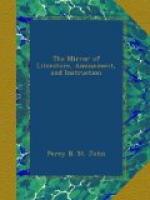on that memorable morning. But our object was
not attained, and we set forward with replenished
vigour, to cross the heather-heath, whose bleak aspect
prepared us for the paradise which smiled below the
other side of the hills. The first prominent object
which met our view, was the terrace, with its classical
temples at each of its terminations; and next, the
wood encircled hamlet of Scawton, at whose little
alehouse we enjoyed a hearty breakfast; and then set
forward to explore our beloved region of Rievaulx;
our path being through a mountainous wood, which nearly
kissed the sky, and obscured the rustic road which
divided it: after several windings through this
leafy labyrinth, we arrived at a point where the wood
was more open, and the dell considerably wider.
It was after passing a picturesque cottage and bridge,
that the first view of Rievaulx Abbey broke upon us.
It was then that the first outline of its “Gothic
grandeur” was displayed to us. Crossing
the little bridge of Rieval, we proceeded along the
banks of the Rye, which morosely rolled along, scarcely
deigning to murmur its complaints to the woody hills
which skirted it, as if in pique for the ruin of its
sublime temple, and the disappearance of its monastic
lords. The village of Rieval, constructed out
of the wreck of the spacious abbey, displays some
reverence for the preservation of inscriptions dug
out of the building; and the little windows which lit
the cells of studious monks five hundred years ago,
now grace the cottages of illiterate peasants.
We took a facsimile of one inscription, in Saxon letters,
merely denoting the name of the monastery.
The rustic beauty of the hamlet has been copiously
eulogized by antiquarians and provincial historians.
The beautiful foliage of its trees, varying in colour,
appears like fleecy clouds of verdure, rising one
above the other, over which a still deeper shadow is
cast by the towering woods on each side of the valley;
and in the midst of this fairy region, as if conscious
of its proud pre-eminence, rises the sacred edifice,
clothed in mourning of nature’s deepest shade:[5]
Oh! many an hour of ecstasy
I past within its fading towers;
When life, and love, and poesy,
Hung on my harp their sweetest
flowers.
To indulge a little in reverie—“how
are the mighty fallen!”—Here was
once worshipped the virgin amidst the glittering pomp
of monkish solemnity; when burst the beams of morning
through the tracery of yon mighty window—
“Shorn of its glass of thousand
colourings,”
and threw the glowing emblazonry of the tinted pane
upon the Mosaic pavement of the choir; while the loud
and slowly-pealing matin reverberated through the
sumptuous church. Here was interred with ceremony
of waxen taper and mid-night requiem, the noble founder
of this dilapidated fane, Sir Walter L’Espec,
beneath that wreck of pillar and architrave and those
carved remains of the chisel’s achievement—he
who deemed that the sepulchre




